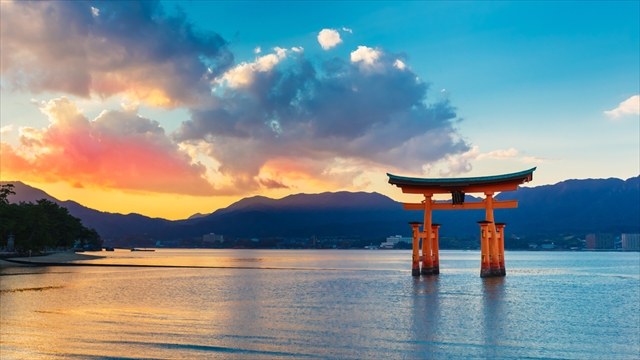
Miyajima, the ancient sacred island which has been worshiped by people for centuries. It is also counted in the Three Views of Japan along with Matsushima of Miyagi prefecture an Amanohashidate of Kyoto prefecture and recognized as one of the most symbolic scenery of Japan. The beautiful views of this island are attracting more tourists these days, especially an awesome combination of the Itsukushima-Shrine, a world heritage site, and Mount Misen mesmerizes people with its breathtaking beauty. So, let’s explore the must-visit spots of Miyajima, the best scenic area of Japan you should never miss out.
Miyajima, the hottest scenic site
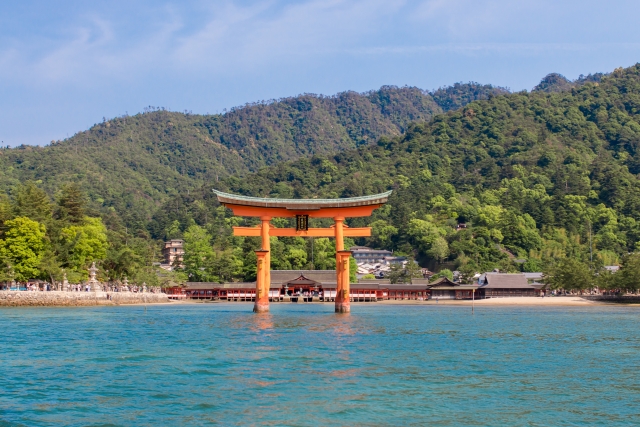
Miyajima is a small island about 30km around, which is located in the beautiful Seto Island Sea of Hatsukaichi-city, Hiroshima. The official name for this island is “Itsukushima”, however, it is commonly known as “Miyajima” meaning “the shrine island” in honor of the historic Shinto shrine. Miyajima has been particularly popular among tourists these days along with the A-Bomb Dome and the Hiroshima Peace Memorial Museum in the same city. Miyajima was ranked 3rd in TripAdviser Best Attraction by Foreign Travelers Ranking 2016. The best attraction of this island is the Itsukushima Shrine that has the magnificent Otorii gate standing in the sea and the celestial vermillion shrine pavilions. It is told that the entire shrine was designed to be perfectly matched with tide changes. It shows totally different sceneries in the morning and evening as if dual-sided, and this is one of the reasons people are so much attracted by this site. Also, Mount Misen 535 meters above sea level stands behind the Itsukushima Shrine. Well prepared with footpaths and a ropeway gondola, this sacred mountain is attracting many tourist who wants to witness the mystical atmosphere and the beauty of Japanese nature. Spring cherry blossoms, beautifully colored autumn leaves, Miyajima shows different seasonal sceneries and enchant you every time you visit there.
Access to Miyajima
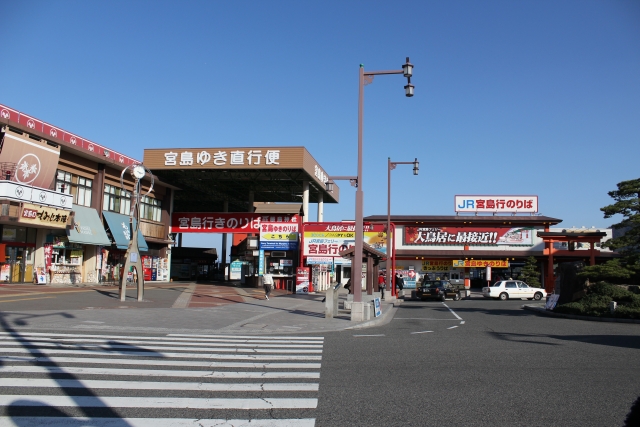
As you know, Miyajima is a small island in the sea. To go to Miyajima from Tokyo, take a shinkansen or flight to Hiroshima, head to Miyajimaguchi, the main port to the island to board a ferry. From Tokyo to Hiroshima station, it takes about 4 hours by shinkansen, or about 3 hours by airplane and train. Form Hiroshima station, take JR Sanyo-honsen to Miyajimaguchi station and get on a ferry. If you can allow plenty of time, you may want to take a Hiroshima Dentetsu tram from Hitoshima stationa to Miyajimaguchi station and enjoy local sceneries from the window. At Miyajimaguchi, there are two ferry lines to Miyajima, JR or Matsudai Line. Both lines charge similar schedules and fees, but JR ferries are more popular as their ferries pass just by the Otorii gate. If you wish to visit the A-Bomb Dome and the Hiroshima Peace Memorial Museum beforehand, the World Heritage Sea Route starts from Motoyasu Bridge to Miyajima. Fees are a little pricier than other routes but handy access and great views attracts a number of international tourists who think a great deal of time efficiency.
Entrance of Miyajima, the Otorii gate
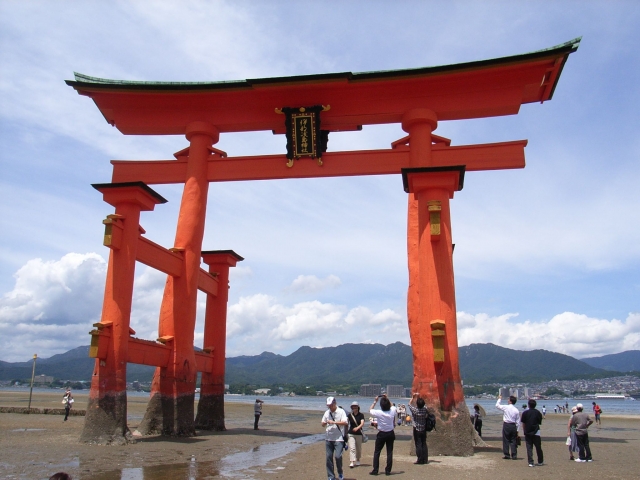
Solidly standing as the entrance of Miyajima, the Otorii gate is recognized as a symbol of Miyajima. In fact, the present Otorii was built in the Meiji period, and is the eighth Otorii in history. Surprisingly, the base of the Otorii is not buried deep in the seabed, but stands by its own weight. Miyajima Island itself has been recognized as an object of worship and hammering nails in such a sacred body was taken as an irreverent manner. Therefore people built this self-standing gate to welcome people who pay a visit to the Itsukushima Shrine. During high tide, visitors can cruise through under the Otorii gate. It is said that entering the shrine on a boat through the Otorii gate was the proper way of visiting this shrine during the Heian period. During low tide, visitors can walk to the Otorii gate on foot. Get closer and look up the gate from right underneath. You will be overwhelmed by this 16-meters-tall great Otorii gate.
The brilliant vermilion pavilions of the Itsukushima Shrine
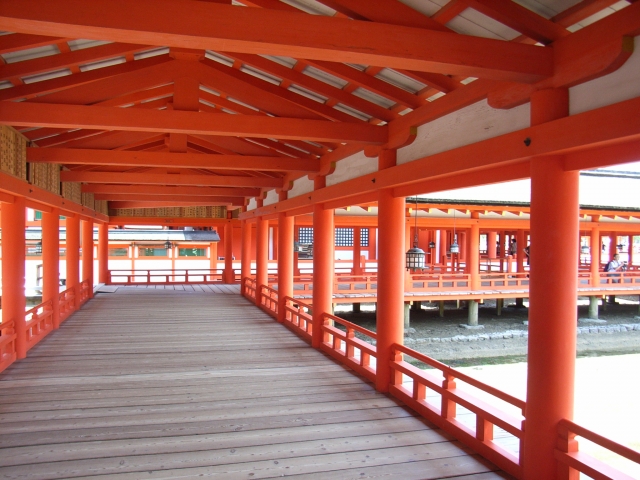
The Itsukushima Shrine is widely known as a shrine standing in the sea. It is assumed to have been built in 593, then the enter shrine was re-constructed to present size. The Itsukushima Shrine is the only shrine that is registered as a World heritage Site by itself. Having been built over the sea, the reason of this unusual architectural structure is the same as the Otorii gate, in attempt to avoid directly building a shrine on the sacred island. When you walk through shrines and halls connected by the bright vermilion corridors during high tide, you can see the sea water raised just under the floor level, and feel as if walking on the water. The beautiful contrast of the bright vermilion columns, the fresh green Mount Misen standing behind the shrine, the blue sky and sea water represents the ultimate aesthetics of the Japanese. The Itsukushima Shrine and nearby sightseeing spots are illuminated every evening from 30 minutes after the sunset up to 11pm. the picture of the shrine mirrored on the pitch-black sea water must dazzle you with mystical ambience.
Explore Mount Misen 1: Miyajima Rope-way to Shishiiwa Observatory
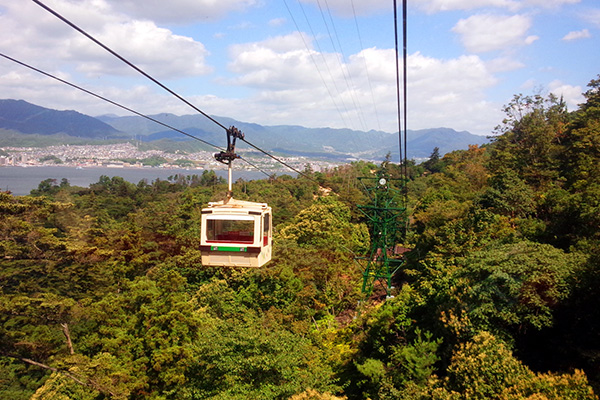
The Itsukushima Shrine is a great attraction of Miyajima by itself. But if you want to know more about this island, go further to the sacred hill Mount Misen, the highest peak of Miyajima which is 535 meters above sea level. If the sky is clear, you can enjoy fantastic panorama views of a number of small islands scattering in the Seto Island Sea. Among a few routes leading to the top of the mountain, taking a rope-way gondola is the easiest and fastest way to the top. A rope-way station is located behind the Momijidani Park. It takes some time to get there on foot, but there are free buses from the Itsukushima Shrine running every 20 minutes. Once arriving at Shishiiwa Station after two gondola riding, you will see the Shishiiwa Observatory (altitude 430m) a little ahead on the left. You can view a numerous number of islands in the blue sea water and ships coming in and out. The views from the Shishiiwa Observatory is beautiful, but if you manage to go further to the top, there are far more fantastic views awaiting you. It is not very far by distance but there are many steps and steep uphill paths, so make sure to wear comfortable shoes.
Explore Mount Misen 2: Hiking trails to the summit and observatory
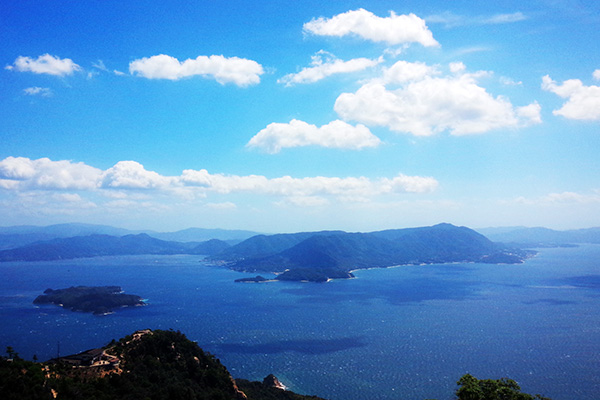
From Shishiiwa Station to the summit of Mount Misen, follow the downhill path first for about 10 minuties and go on the uphill trail for about 20 minutes. You can drop by Misenhondo Hall, Sankido Hall which is the only shrine that enshrines ogres and other places on the way to take a little break. Once you duck under the Kuguri-iwa, a spontaneous arch made of gigantic rocks, you are almost there. On the summit of the mountain, there is a tree story observatory building which was rebuilt in 2014. You will never forget the breathtaking panoramic view from the third floor with no obstacles. You may see mountain ranges of Shikoku Island if the sky is clear. The second floor is a room to chill out. Visitors can sit on a chair or lie down to rest and view the beautiful scenery of the islands in the sea. After getting refreshed at the observatory, head back to Shishiiwa Station. Don’t forget to check timetable of rope-way gondola beforehand and allow plenty of time. If you miss the last returning gondola, you will have to walk all the way down to the bottom on foot.
Beautiful experiences in the island of goddesses
The beautiful and mystic sceneries of the Itsukushima Shrine accented by tide changes. Fantastic views from a gondola up in the air and the rich nature of Mount Misen. If you have a chance to visit Hiroshima city, don’t forget to experience these two spots in Miyajima. In addition, you can enjoy delicious local foods such as fresh oysters, Anago-meshi (grilled conger eel with rice) and freshly baked Momiji-manju buns. Also, you can see many sweet eyed deer, which are recognized as divine messengers, strolling around between the ferry port and the Itsukushima Shrine. Remember, unlike deer in Nara, you are not allowed to feed deer in Miyajima.
